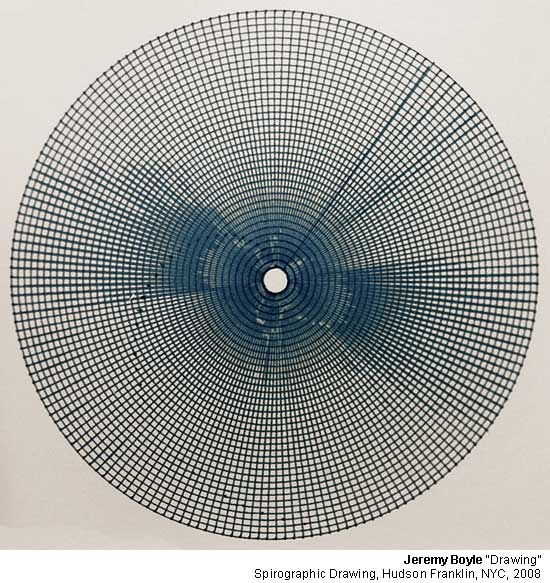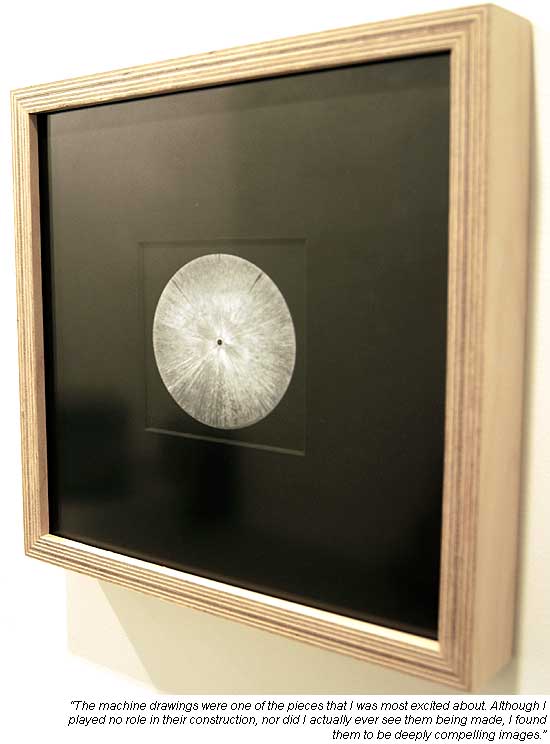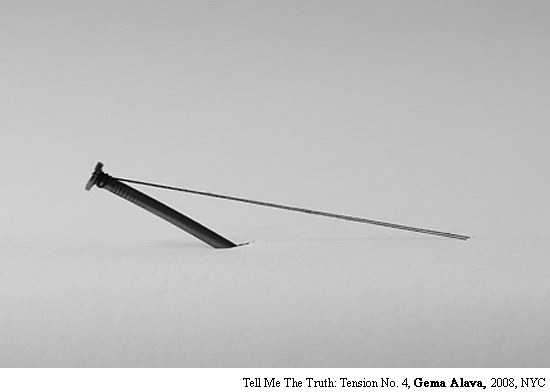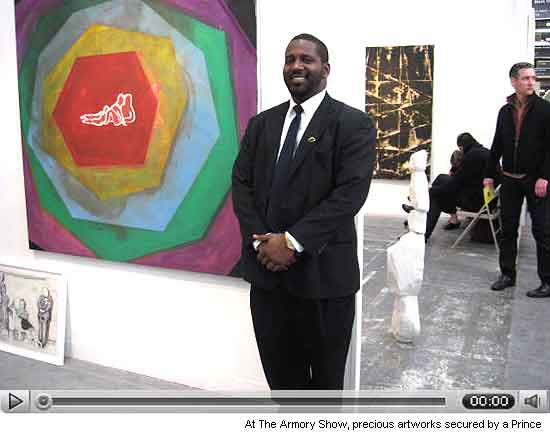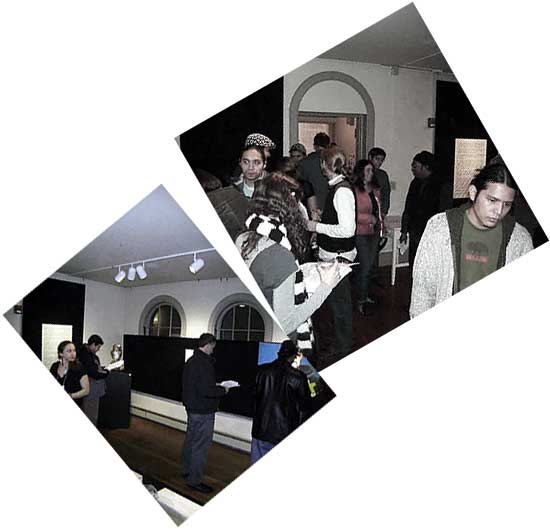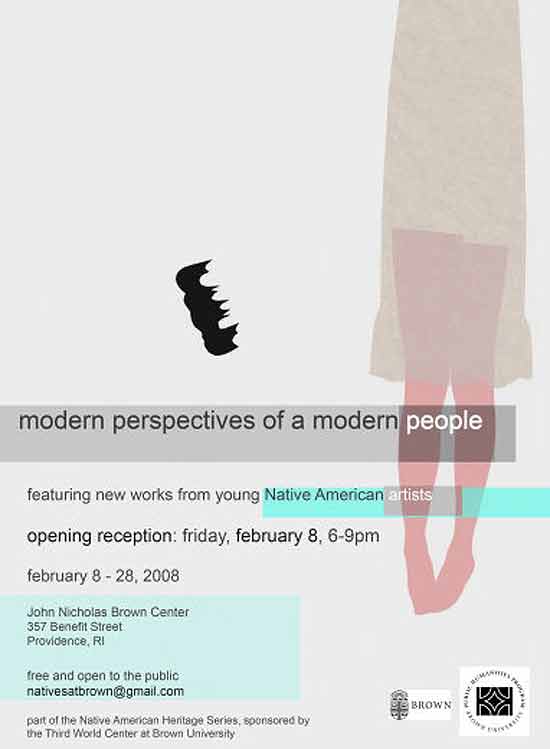Entries Tagged 'Uncategorized' ↓
Thursday, May 1st, 2008
Alison Knowles Tate ModernLondon Times: Make A Salad
From: Alison Knowles
To: Joshua Selman
Subject: Tate rated
Date: Sun, 27 Apr 2008 18:15:11 –0400
Josh: The event score to be performed at the Tate in London on May 24th at four o’clock in the afternoon is from the Great Bear Pamphlet By Alison Knowles published in 1964. The proposals for performance are labeled “propositions.”
#2-Proposition (October, 1962)
Make a Salad
Premiered October 21st, 1962 at the Institute for Contemporary Arts in London, I made and served up salad for perhaps 20 people.
Visiting the Turbine Hall is like standing in Grand Central Station at rush hour. Around 1900 people each day will attend what is titled the Fluxus Long Weekend. My friend Larry Miller and I are the arrangers of the event. He will do the Fluxsports and I the Salad. The other days will include collaborative pieces with performers they provide from Goldsmith college and I will also do a sound work called Newspaper Music. I am very honored by the invitation.

The Tate has been very cooperative with me in my structure for the performance and I in turn have yielded to their demands. They are both large and prestigious and have certainly made salad for special guests over the years, however the differences are significant. My audience must see and hear the salad in production before they can eat it. The first roadblock we surmounted was the actual performance site. I chose the bridge overlooking the entire space. The bridge is about twelve feet wide and approximately four metres from the floor below.
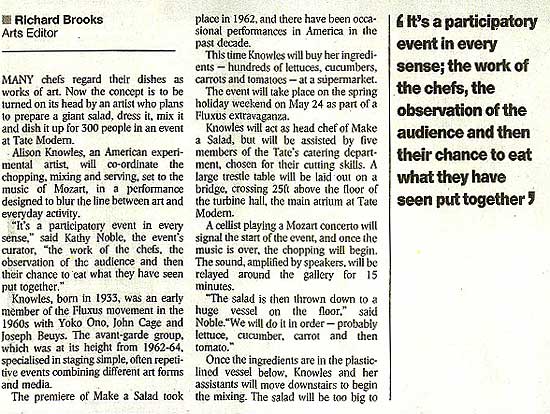
The salad will be selected by the head chef, that’s me. The five other chefs they are providing will arrive with their own knives and implements for cutting and shaving vegetables. Chefs, I learned, never share their knives. They will all accompany me the day before to the Borough Market (nearby and the best in London they say) and help select the vegetables flowers and fruits to make a salad for around 500 people. Five hundred people is the figure that was printed in the London Sunday Times Ad this week at any rate. There will be no limit or selection of the people invited to eat. We will eat until it is gone. The table of preparation will be contact mic’d beneath, and the sound spread through the space with a PA system.
All the ingredients will be clean and bagged before we begin. Beneath the bridge a tarpaulin twelve meters square will be spread. It will receive the radishes, olives, violets, rose petals, carrots, tomatoes, at least three types of lettuce for sure. These ingredients will float down, thumping and bouncing and raining down from the bridge to the tarp below . The tarp will be held up at the sides and corners by only the most gifted students from Goldsmith college! The dressing will be dribbled over from the bridge. They promise canoe paddles and a sterilized garden rake for the mixing process, the tarp by now being too heavy to lift. I wished my grand daughters to do the raking in sterilized rubber boots, but this did not pass.

A Mozart quartet will initiate the chopping and when the salad is complete the quartet will finish the selection signaling the serving operation. The music of Mozart and the music of chopping have found a place together at last in contemporary sound art thanks to Proposition #2 and Lucy Railton who heads the quartet.
I have bowed to the hygienic demands of the institution, which has gone through hard territory with the English health department to have a legal salad. We have agreed to wear net hats and gloves but not mouth masks. They (five curators) have “adjusted” the small restrictions and we do have the approval of the Bank of England (really) who will be funding the Fluxus Long Weekend. I am confidant we will not be arrested. I wish the salad to be stupendous not sensational. We know that if we could get this world together there would be enough salad to feed everyone and that’s the metaphor.
So, if you find yourself in London in May come to the Tate at four o’clock on the 24th and we can all pitch in, pitch it over and pull it off.
Alison Knowles for Artist Organized Art April 27 03
#permalink posted by Alison Knowles: 5/01/08 10:31:00 AMFriday, April 25th, 2008
Jeremy Boyleat Hudson Franklin Gallery, Chelsea
Mar 20 – Apr 26 2008
correspondent: artist Nicholas Sullivan
Jeremy Boyle’s ingenuity ranges from everyday three-word emails to his students, to solo art shows, like the one now at the Hudson Franklin Gallery in Chelsea, New York. As a student of Jeremy’s, I found his approach to instruction deeply refreshing. Coming from a high school where the emphasis and concentration was either on drawing a tree outside the classroom on a piece of paper with oil pastel (in, gasp, unrealistic colors) or churning through the ridiculous number of still life requirements for the AP art portfolio (I got a 3), Jeremy’s take on the foundations program at UMass made me realize the limitless possibilities within the realm of “art.” No longer would I slave at a charcoal self-portrait, nor would I even take a gander at a set of oil pastels. A new world had been opened up, and I was sailor-diving into it.
I have taken four different classes with Jeremy. It is always quite an unusual comparison between the classes I take with other professors and the ones I take with Jeremy. Where some instructors concentrate overwhelmingly on technique, and what I deem as replication, Jeremy instead pushes concept. We have talked a number of times about the power and value of teaching conceptually strong art earlier in an artist’s formal training. An artist with a strong concept, and the will to achieve it, will take those steps to make it happen. Thus the technique follows the concept. Creative freedom is exactly what Jeremy gave me. It is then when art really became exciting, when those doors were open and the vast expanse of everything lay open before me. It was wonderful.
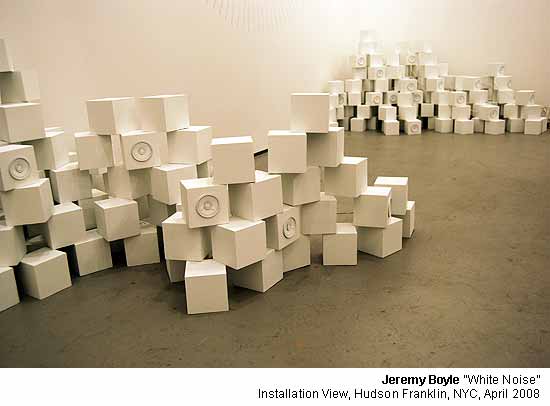
From that point on I was brimming with ideas, some rather outlandish, and some a bit more conventional. Regardless of the idea, Jeremy’s expertise and general knowledge on just about everything constantly came to the rescue. At one point, for instance, I attempted to make a Jell-O mold for a project. I was never able to complete the project, but I brought up my failed Jell-O attempts to Jeremy and off the top of his head he gave me a list of ways that Jell-O could solidify faster as well as hold its shape better. How he knew this was something I ponder quite frequently. Instances such as this occur on a daily basis with Jeremy. His capacity to help, and to provide information is boundless.
During this current semester I had the opportunity to work with Jeremy as his assistant preparing for his show at the Hudson Franklin Gallery. Every Saturday for about a month or so, I was over at the Boyle residence ready to rock and roll … or sand and paint. The first day we spent the entire day cleaning an astonishingly thick layer of sawdust off everything in his studio. The rest of my days were usually spent working and reworking the exterior of the small wooden boxes involved in his White Noise piece. We deduced at the end of the entire process that each box (there were approximately 250) took around an hour of labor. But, might I say, dear god they looked good. I loved sanding, spackling, and painting. Jeremy’s ipod provided a plethora of new musical discoveries, and I routinely encountered bands I had never heard before (my first day on the job I played 5 straight hours of Morrissey–something that I believe now may have been slowly driving Jeremy insane). The process was exciting to be a part of, and I know that many of my other professors, sadly, would have no art to need help on. Having a professor who is a successful working artist is something that I feel is invaluable. Jeremy’s dedication spanned out of the classroom and into his own studio space, where he spent hours going over every meticulous detail of his pieces, exemplifying a practiced and precise level of craftsmanship.
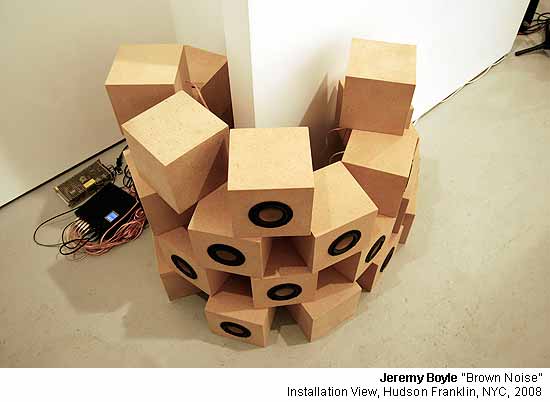
As the show neared, we packaged up the stuff and Jeremy made the long voyage to New York for his installation (which was apparently quite grueling). A few days later a few classmates and myself made the journey to New York for the opening. As we approached the gallery we saw approximately thirty people waiting for the elevator just to get up. I thought to myself, “This is like a godamn Kiss concert.” I hadn’t expected to see such a huge turnout.Jeremy’s work in the show, I think, can be viewed on a number of levels. But, for the most part I view it as an explanation of the ironies and idiosyncrasies of human behavior, as well as exploring the close relationship of process and creation. For example, his piece involving the large circular screen with the rotating projection, and the video on a rotating pedestal, both deal with similar ideas. The dichotomy that existed between the two pieces I thought was one of the most important of the show, and really embodied ideas reflected in a lot of the other pieces (more on these works below). It is these minute observations that Jeremy is able to delicately bring to the forefront and make obvious. Our human experience is under close scrutiny by Jeremy Boyle, and I think his art will tell you that. Jeremy’s sound pieces also seem to illustrate a certain form of dissection and re-contextualization. Since the gallery was so packed, it was hard to hear the white and brown noise pieces, but I felt that their relationship existed similarly to that of the two video pieces. The machine drawings on the walls were something that I never was able to see the actual construction of, nor had I seen the devices that created them. It seemed unimportant to me because I have seen how Jeremy works, and the work around the drawings explains them completely. The self-playing guitar (I think all of UMass has talked about his self playing guitar) was a manifestation of what Jeremy had been teaching our small independent study class about electronics. It is just so visually complex, and so actually complex, it nearly exists in another realm of understanding. It becomes for me something very different than a guitar.
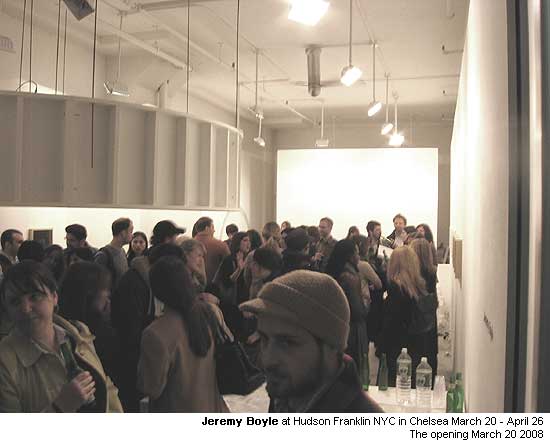
Jeremy was able to show a lot of brand new, and newly refurbished work in this show, and individual pieces are situated in ways that help individual pieces complement each other in interesting ways. For instance, as viewers enter the gallery space, they immediately encounter a large circular construction that is hung from the ceiling screen (one layer of Spackle, one layer of primer, two top coats) at eye level. Projected on the inside of this circle is a digital image of Jeremy’s head. The image of Jeremy’s head rotates around the inside of the circle. Similarly, nearby, there is another video piece involv
ing rotation. In this case it is a video that stands on a rotating pedestal, with again another rotating image.
In two corners of the room were some of Jeremy’s sound pieces, one being White Noise, and the other Brown Noise. The white noise boxes (which I worked on) were approximately 3″ x 3″ inch white cubes, some with speakers in them and some without, all stacked on top of each other in a pile. The piece emits a soft hum of “white noise.” Nearby was the similar Brown Noise piece, made of brown boxes a little bit larger (about 6″ x 6″) arranged in the same manner and form as White Noise. Finally, Jeremy’s self-playing guitar, a complex electronically based instrument made to play without any help of the human hand, and instead running off a micro computer, electronics, hydraulics, and a lot of highly advanced programming.
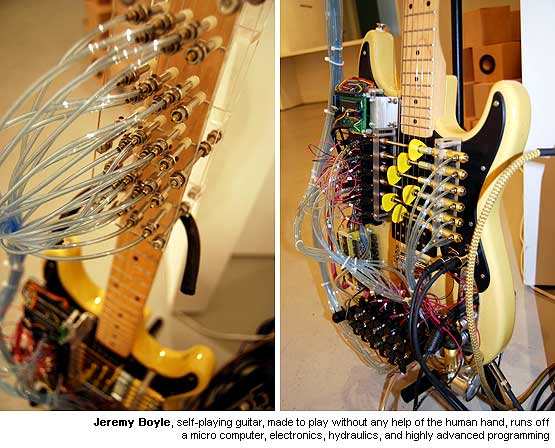
The machine drawings were one of the pieces that I was most excited about. Although I played no role in their construction, nor did I actually ever see them being made, I found them to be deeply compelling images. The complex images rendered by Jeremy’s hand-made machines seemed to fit perfectly with his other pieces that showed some of his elaborate electronic handiwork, such as the self-playing guitar. I find the idea of removing the artist’s hand almost completely from the final product, and really having the artist’s role exist behind the scenes a compelling idea. Upon closer inspection these machine drawings, done in a surprisingly simple ballpoint pen, have their imperfections. The process did not produce perfect drawings, but it was these mistakes that really drew me to them. Seeing the areas where the pen began to run out of ink were the most aesthetically pleasing, and the most interesting, as the flaws in even a mechanical design are exposed.Jeremy’s large wall Spirograph seems to play off of Jeremy’s use of machines as well, although in this case the artist’s hand is visible, and the machine is instead just a facilitator. Rather than in the machine drawings, this Spirograph just literally guides Jeremy’s hand to make the pattern. In this case, there is a closer connection between the artist and his materials and final product. On another level, the Spirograph hints at a certain youthful vigor that Jeremy seems to occasionally play off of within his work. This can also be seen in his use of the ballpoint pen, often in my case associated with school-book scribbles and haphazard note taking. But, upon closer inspection of what the Spirograph really is (a series of gears within gears that creates mathematical curves in a very specific manner) you are able to see where the connections in Jeremy’s work begin to be made.
Finally, a piece that I have grown to know and love, whether it be because of my role in its production or its simple genius, is White Noise. I have found a place in my heart for this piece. “White noise” by definition is a signal with equal power across all frequencies. Jeremy’s piece was approximately 250 small boxes stacked on top of each other, some with speaker playing a level of white noise out of them. In this piece Jeremy actually provides a physical representation of sound, while including the sound that is being represented. Although during the opening the white noise was hard to hear coming out of the speakers (unless your ear was directly against them), I had heard them previously and the actual white noise that emits is quite interesting. It is a short of high hiss sound. This piece is accompanied almost directly across the room by the Brown Noise piece, and this created an interesting relationship within the gallery. The two pieces were speaking to each other in their different pure forms of sound, carrying on a kind of conversation. The literal stacking of the boxes creates an almost post minimalism take on sound. The White Noise and Brown Noise pieces both literally and figuratively converse with each other, describing an arena where audio landscapes are transcribed into physical realizations, thus providing. Similarly, the Spirograph wall drawing, and the machine made drawing also hold a dialog which suggests a distinct relationship between creator and creation, as well as the imperfections of not only the human hand, but also the machines.
After the show I felt a bit of remorse, knowing there would be no more topcoats to put on, no more boxes to sand, and no more Morrissey playing in a dusty studio. But from those days I spent in Jeremy’s studio, and from the time I spent with him in the classroom, I have learned a great deal not only about art, the art world outside of college, but also life itself. Jeremy Boyle works hard, he works very hard, and it shows not only in his show at Hudson Franklin Gallery (which I think was a tremendous success), but also in his students’ loyalty and dedication to his teaching. Jeremy does not gain respect from his students by being loud, or by enforcing rules and deadlines. Jeremy gains a students’ respect by being a teacher, by being kind and generous, and by doing what he does best: creating amazing art.
In the end I am constantly left questioning whether my college experience, and my parents hard-earned dollars, are worth a BFA, which in my mind really means nothing. I think often of a philosophy student. A philosophy student is taught philosophy, only in most cases to become a philosophy teacher, thus creating a static cycle. But there is always that one Nietzsche, or that one Marx. Similarly, this is true for the art world. It is not really about the diploma, or AP portfolio, but instead it is about working hard for what you want. College is merely a way to facilitate that. Jeremy’s show at Hudson Franklin is a manifestation of what I am working for during these four years, and I will be eternally grateful to him for showing me that.
-Nicholas Sullivan
Born in Pittsburgh in 1975, artist/musician Jeremy Boyle received his BFA from the University of Illinois at Chicago and MFA from the Ohio State University. He was a founding member of the Chicago group Joan of Arc and has performed music (both solo and collaborative) extensively throughout the United States, Canada, and Japan and his recordings are internationally distributed. He has exhibited artwork, most of which is sound and technology based, in major cities across the U.S. including Chicago, New York, Los Angeles, Boston, Sacramento, Seattle,Miami, and Pittsburgh. he was awarded the PA Council on the Arts Fellowship in 2003, received the Heinz Creative Heights Award and completed a residency at the Mattress Factory in 2004, and received a Sprout Fund Seed Award in 2005-6. Recent projects include the completion of a public artwork commissioned by the Pittsburgh Downtown Partnership and the Heinz Endowment in collaboration with architect Gerard Damiani and a solo exhibition at the Hudson Franklin Gallery in New York City. he is currently an Assistant Professor of Art at the University of Massachusetts at Amherst. His work has been most recently seen at Deadtech in Chicago, IL, and at a mini-tour of performances last fall featuring his (self- playing) guitar and drums. Also in 2007, Boyle created the score for Jennifer Reeder’s first feature film, “Accidents at Home and How They Happen,” which premiered at the Wex
ner Center for the Arts in Columbus, OH, on March 1. This is his third solo show with Hudson Franklin.
Nicholas Sullivan is an emerging artist completing a degree at UMASS Amherst where he has studied closely with and worked as assistant to artist Jeremy Boyle.
Hudson Franklin Gallery, 508 W 26th St., NYC, was established by Nicole Francis, a graduate of the School of the Art Institute of Chicago’s MA program in Art History. Artists at Hudson Franklin includ Michael Bernstein, Jeremy Boyle, Jesse Chapman, Martin Esteves, Peter Fagundo, Alice Konitz, Elizabeth Saveri, Genevieve Walshe
#permalink posted by Nicholas Sullivan: 4/25/08 10:16:00 AMWednesday, April 23rd, 2008
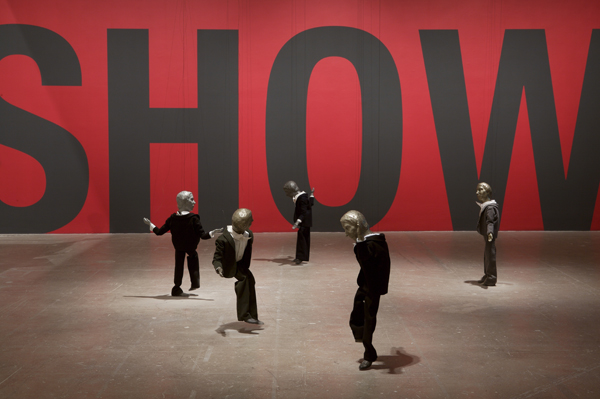
Dennis Oppenheim. Theme for a Major Hit, 1974. “The Puppet Show.” Installation view.
Institute of Contemporary Art. University of Pennsylvania. Photo: Aaron Igler
Puppets, Mortality, Humor and Suffering;
Three States, Three Venues Explored
AOA correspondent: Artist Eva Mantell
The Puppet Show, Institute for Contemporary Art in Philadelphia, Pa, from January 18 to March 30, 2008; traveling to the Santa Monica Museum of Art; the Contemporary Museum, Honolulu; The Contemporary Arts Museum, Houston; Frye Art Museum, Seattle.
Bianca Neve, Teatro del Carretto, LaMama E.T.C., NY, NY,
January 10 – 27, 2008; Teatro Araldo, Torino, Italy, April 18-19 2008
Argonautika, The Voyage of Jason and the Argonauts,
directed by Mary Zimmerman, McCarter Theatre, Princeton, NJ,
March 20 – April 6, 2008
Puppets look easy, child-like and direct. They are obviously about the body, about power, about imagination, about the self, about comedy and about mortality.
Any artist can drop in on this art form and give it a try. A puppet could be made from anything: your hands (Cindy Loehr gives us a video with talking fists which quickly reminds me of “The In-Laws” with Alan Arkin); your genitals (Guy Ben-Ner’s video gives a sometimes shy body part a star singing role); your whole body as you act like a puppet (Paul McCarthy, scary clown slopping paint around for us).
Puppets are about drawing and about sculpting too. Film, video, computer animation too. Robotics (Survival Research Laboratory lavishly blows up robots, which is certainly one approach). I think the thing vacuuming my neighbor’s home right now is a puppet. I’m pretty sure some of my children’s pets are puppets, that “live and die” by various digital reenactments of nurturing. And this month I had my first sighting of a Baby Think It Over Doll at, where else, the mall! A teenage girl, right out of an after-school special, is dutifully carrying her puppet baby, waiting for its electronic wail, her cue to turn a key in its back while it digitally records her mothering skills. Looking at her a little more closely: does she or doesn’t she? Is she also wearing a strap-on empathy belly?
http://www.enasco.com/product/SB43113G
Where, America, can you get a brain to strap on?
Memories can be strapped on or strung up: by Kiki Smith, Louise Bourgeois, or by Dennis Oppenheim with his mini-me’s. Playing with dolls can transport you to the realm of fear. Natalie Djurberg’s romps in a cardboard world are kinda sick, kinda cruel, kinda cool. Kara Walker’s shadows time-travel into a conflicted, messed-up American history. Her elegant lines are an ironic pleasure, a facade for the crude sadism that is the real story.
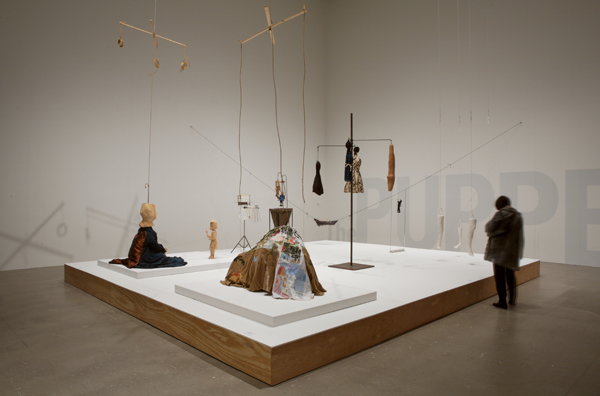
“The Puppet Show.” Installation view. Left to right: Anne Chu, Louise Bourgeois, Kiki Smith,
Annette Messager and Maurizio Cattelan in the background. Institute of Contemporary Art.
University of Pennsylvania. Photo: Aaron Igler
Take a break with someone else’s problems: Bruce Nauman’s dinner date gone yucky. Doug Skinner and Michael Smith’s potty mouths. The body and the world are about failure. Things regre
ss then fall apart. Chaos was a greek proto-god who got in at the ground floor. Ubu Roi, an early expression of things gone ape-shit almost gives a classical feeling to stuff going beserk.
Ubu Roi and the Truth Commission, a play from South Africa, with William Kentridge on visuals, riffs on this little archaic psycho-policeman. The brutality of the regime, the document-shredding, the erasing of crimes, create, warp and envelop the testimony of the citizens’ suffering. This stuff is real and the art is just mediating the experience. Being good or bad art doesn’t matter so much as that it just is art, and art helps me be human in the face of unbearable absences of humanity.

Just do art, and keep it coming. Teatro del Carretto’s Bianca Neve (Snow White) at LaMaMa E.T.C. feels Medieval, distilled, sorrowful. A velvet lined box opens up in different ways to reveal shifts of scale, humor and suffering…from the miniature 7 dwarves to the terrifying full-scale actress portraying the witch/queen with an unmoving mask.
The mask that doesn’t move and the strings that don’t work are the stuff of nightmares. What we most need is agency in the world, connection, love, action and reaction. In the play Argonautika at McCarter Theatre in Princeton, early on, a marionette puppet of a baby wiggles its arms and legs making eager clicking sounds. I laugh at the repetitive, silly motions, but laugh too soon because now the king’s henchmen cut the strings, and leave it dead, noiseless, still on the stage.
Any fool knows that plaster, wood, screws and glue don’t add up to life, but puppet that I am, my heartstrings are pulled and here come the waterworks.
#permalink posted by Eva Mantell: 4/23/08 07:38:00 AMWednesday, April 2nd, 2008
Gema Alava: “Tell Me the Truth”at Messineo / Wyman
! Extended to May 2 !
March 20 – April 26, 2008
Messineo Art Projects and Wyman Contemporary
227 West 29th Street, 4th Floor (# 111)
New York, New York
by Ted Mooney
The truth is a hard apple, whether thrown or caught, as this young Spanish artist clearly knows. She tends, at her best, to think three or four moves ahead of her work’s viewers-not out of disdain for them or out of personal elusiveness, but simply to allow herself room to adjust her own thinking in relation to the effect her imagery has on her (rapidly growing) audience. One even gets the sense that these adjustments are what she’s most interested in. And that, if correct, is promising news indeed.
Alava’s most recent show, thoughtfully installed in Messineo / Wyman’s tiny 29th Street space, is breathtakingly elegant, deftly using the gallery’s space limitations to the works’ advantage. On exhibition are nine black-and-white silver gelatin digital photographs, printed on fiber paper and individually framed in white maple. Each work depicts, toward the left side of the print, a nail of indeterminate size-no scale is established in these works-protruding from a light gray, almost bluish ground that subsumes both foreground and background. Meanwhile, toward the right side of each print, emerging from a hole in this same placeless gray-blue void, are a few black threads, which seem to have ventured out along the ground to wrap themselves around the nail at midpoint or higher in what appears to be an attempt to uproot it from the security of its hole. A struggle, then-and so, inevitably, the appearance of a narrative. Each print shows the two elements-nail and thread-in a different state of dominance or submission relative to one another. At times the nail leans rigidly away from the threads, drawing them so taut they seem to fray almost to the breaking point. At others, the threads, exerting no less force, bend the nail savagely toward them, flexing it and nearly extracting it from its stubbornly held position. Occasionally, the two forces reach an equilibrium, though whether in exhaustion, momentary truce or even a hard-won peace, it’s hard to say.
At least on first encounter, it would be all but impossible for the viewer not to see in this struggle, which is presented to us as if on a completely featureless proscenium stage, the successive seasons in an emotional, probably romantic, human relationship. It could even, if the “time” interval between prints is imagined to be much shorter, be thought of as depicting various moments in a single act of lovemaking. The nail is undeniably phallic, the threads undeniably tactical in their approach and adaptive in their manner of struggle, almost certainly feminine. But no sooner has the viewer hit upon this fairly obvious thought-one even the most completely unreconstructed, frankly fanatical formalist would be hard-pressed to deny-than other, totally different questions begin to bubble up, one after another, in almost alarming profusion.
These questions begin with purely pragmatic speculations as to how these scenarios were physically created. The background suggests a space that is either infinite or non-existent, and, like someone who has just witnessed a magic trick, the viewer is seduced into trying to figure out how this effect was accomplished. Whether one arrives at a satisfactory answer or not, these speculations segue very quickly into the oddly threatening realization that there are absolutely no clues as to what the scale here might be. The force of the depicted struggle (as well as the size of the rather large, horizontally formatted prints) makes it hard not to succumb to the illusion that the stature of the protagonists-nail and thread-is equally epic. And yet when was the last time you saw a ten-foot nail? By now the sense that you are being manipulated is so strong that you begin to question everything. Where exactly can the physical tableaux that appear in the photographs be found? Why aren’t you being shown them, instead of what suddenly seems like photo-documentation of the real works, which are being denied you? Did the “true” art work somehow slip away between its physical embodiment and the trace of it preserved in the photograph? Or is the photo itself the art work?
And if these simple physical matters cannot be pinned down, then what about your earlier snap-judgment-strongly reinforced by the linear, apparently sequential installation of the photographs-that together they constitute a definite narrative, from image one to image nine (“The End,” as it were). Could the photos be resequenced so as to make a different “story”? Is the story you take from the photos really there, or is it a story you make from them because that’s the story you know: your story. Naturally, you then try looking at the prints in different orders to determine the possibilities. And so, by degrees, and quite unexpectedly, you find yourself stranded on a sparsely populated plain in the land of Beckett-or, more befittingly, given the artist’s Spanish background, that of Salvador Dali. (Note the Dali-esque shadows cast by the nail.) The seamlessness with which you have been transported from an almost cartoonishly amusing allegory of human relations to a place where some of the darkest fears and needs of the human heart are enacted-enacted and reenacted over and over again unto death-suggests that the artist’s intentions were, just possibly, not quite as innocent as you may have assumed. What you still have left to go on, however, is the title of the show: “Tell Me the Truth.”
To ask someone to tell you the truth-not a truth but the truth-is to instantly vaporize for good the very object of your request, the one that was so comfortably within your reach until you opened your mouth. Now the possibility of knowing the truth you asked for is forever denied you, because it died the moment you expressed your desire to hear it. This is something all unfaithful lovers know. And, however much we might wish it otherwise, when it comes to the truth, we are all of us unfaithful lovers.
Gema Alava’s work carries an uncanny power whose sourc
e lies precisely in how lightly she offers it. Often made from the humblest of materials, her art nevertheless gives off just the faintest trace of intense and prolonged concentration. Modest in scale, frequently fragile, it makes you think not of modesty or fragility but of resistance and struggle, life and death, the largest matters. Alava has a gift for effortless reversals that she does not hesitate to use in making her mortal point. And that point, more often than not, has to do with the universality of human suffering-cast by her, at times, in a Spanish key, for Spain’s suffering at the hands of history is well known. But the artist is under no illusion: such suffering is a condition of life, not of nationality.
Alava’s show remains open until April 26. See it now, before she becomes too well known for her work to be shown again in such intimate quarters.
copyright (c) 2008 by Ted Mooney
Artist: Gema Alava born Madrid, 1973. MFA San Francisco Art Institute, 2000. Her work has been shown at The Bronx Museum of the Arts, The Queens Museum of Art and, thanks to the generous collaboration of Cai Guo-Quiang, her latest art project took place at the Guggenheim Museum, New York, February 21st 2008.
#permalink posted by Ted Mooney: 4/02/08 01:05:00 PMTuesday, April 1st, 2008
Rough and Ready at Pier 94The Armory Show
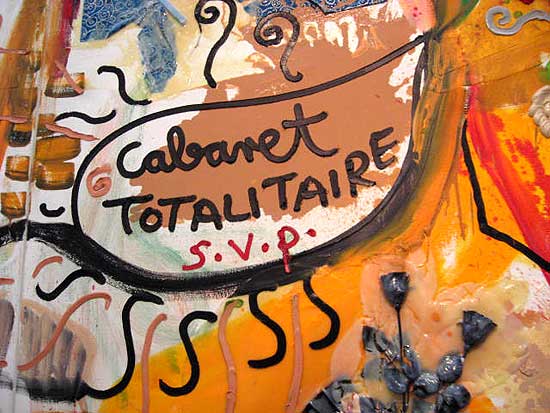
Jonathan Meese detail at Contemporary Fine Arts, Berlin
by artist Alison Knowles
For AOA
Convinced by a friend that I should see more art that is almost next door I ventured out with Bonnie Marranca of Performance Art Journal to the Armory show at 12th Avenue and 55th Street. Commenting that this is hardly next door on a cold March day she smilingly retorted. “There will be coffee. “Once inside there in my immediate sites was Leah Fried of the Lombard Fried gallery. She had the best show at the fair for my vote. His name is Michael Rakovitch, a third generation Iraqui American who started out by putting his sculptures in his fathers Import Export store on Atlantic Avenue. The work was so compelling one had to pick it up and look closely. About twenty small sculpture filled the table: dogs, shoes, lamps, perhaps all rejects from his father’s store I imagined. Each piece wrapped in a daily newspaper, impeccably glued and adhered smoothly so the Arabic or Turkish or English could be read. One had to guess the object that supported the newspaper accounts.
Leah was one of many friends that had shown up for this fair and she pointed the way to another series of works by Emily Jacir. These were clearly Fluxus like event accounts, suggesting to walk a certain street in Gaza and find one corner to observe. I decline to take the Gaza walk at this time, but the pieces were evocative of what this young Palestinian was going about to make art from her torn homeland. Then turning around there in my sites was artist/student from Cal Arts, Aviva Rahmani now in Maine. She is an artist doing a PHD as part of her “art practice”. Her field is ecology and she has repaired a huge pond water-site in Maine. Today she said “we have to think of knowledge particularly science as the material of art”. It is up to artists to start thinking and make their own archives available she said, as loose theoretical writing and reportage have made it necessary for artists themselves to communicate what they are about. I mentioned AOA to her: “It was great getting in with AOA. They said ‘we don’t care if you’re an artist, you have to be a writer to get in here.’ Fortunately, my Shoreline had my name attached as writer.”
Around another corner I found a work by Idris Khan titled “Hearing Voices”. A large spread of grayish notes based on a Schumann concerto had been transferred as a digital c-print onto aluminum, a glowing beautiful work. Finally with coffee in hand I could sit for a moment with Dominique de Menil, a strong and generous contributor to the work of John Cage for decades. She is the remarkable person who bought and island in the Caribbean and built a college there.
Julie Harrison informed me that Steve Clay at Granary of Granary books was not present but caring for the kids. She was sipping tea on a huge cushion.
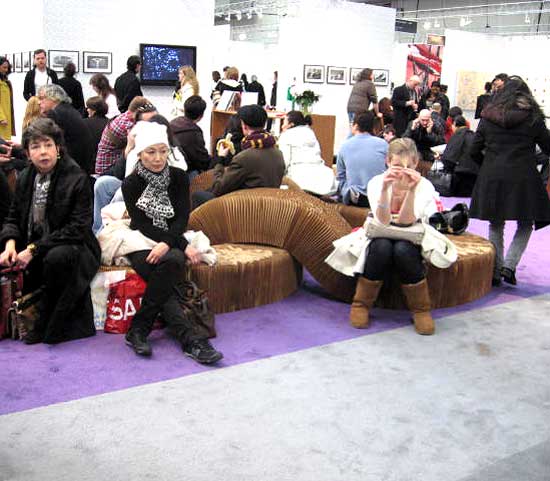 “At The Armory Show an air of orderly professionalism pervades…”On the news just now I see that artis
ts in Brooklyn have rented a dumpster and are showing digital tapes inside for free entry. Because I am a member of Artists Organized Art I was able to bypass the line and get free entry by showing a work Shoreline on the Internet. It worked. They gave me a badge and let me through. The line was more than a half hour long and the fee $30. I disagree with this situation of large fees for museums and fairs. Clearly I better stick with those enterprising artists renting a dumpster in Brooklyn.
“At The Armory Show an air of orderly professionalism pervades…”On the news just now I see that artis
ts in Brooklyn have rented a dumpster and are showing digital tapes inside for free entry. Because I am a member of Artists Organized Art I was able to bypass the line and get free entry by showing a work Shoreline on the Internet. It worked. They gave me a badge and let me through. The line was more than a half hour long and the fee $30. I disagree with this situation of large fees for museums and fairs. Clearly I better stick with those enterprising artists renting a dumpster in Brooklyn.
photography: Erika Knerr
#permalink posted by Alison Knowles: 4/01/08 09:03:00 AMSunday, March 30th, 2008
Armory Show, NYC 2008The “Business As Usual” Slideshow
#permalink posted by Artist Organized Art: 3/30/08 06:53:00 PMMonday, March 10th, 2008
Modern Native American Artists
Artistic Expression: Modern Perspectives of a
Modern People
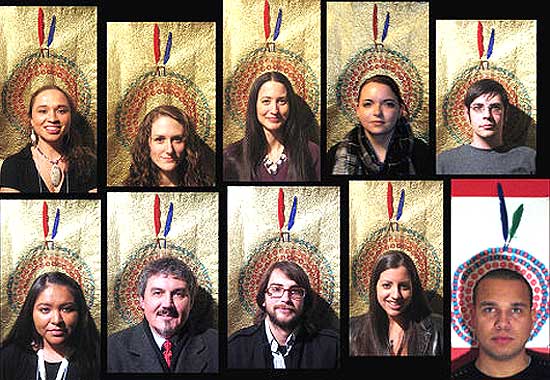 Dan Loudfoot, Everyone Wants To Be An Indian, participants, backdrop and photo document
Dan Loudfoot, Everyone Wants To Be An Indian, participants, backdrop and photo document
A Native American Heritage Series Event
February 8-28, 2008
John Nickolas Brown Center
Brown University, Providence RI
by participating artist, Nayana Glazier
Friday February 8th was a day that I was apprehensive would ever come. I also never imagined it would happen with out my hands-on involvement. But a little over a month previous I received an email from Mikel Brown co-programmers of Native Americans at Brown (NAB) I was surprised. She explained to me their plans for an exhibition at the John Nicholas Brown Center at Brown University.
I experienced apprehension in the days leading up to the event. This came from the original reasons why Loudfoot, Echo-hawk and I had been planning the very same type of event previously. I wondered what the backgrounds were like for the other artists whom I was not familiar with. Did they have these same feelings? Did their work express the same ideas? Being of mixed blood would that affect their view of me or my work? These are all questions that I think all of the artists involved in this show probably thought in the days leading up to the reception.
Then it came, reception day, large white building with pillars and a stonewall with gate. We found our way in through the carriage house to what resembled a small parlor converted into the style of gallery you would see in most higher end New England colleges. Almost a cliché considering the subject matter of the exhibition. After hanging coats I found my way into the gallery to explore the works. Armed with my name tag and the knowledge that others were looking at me the same as I was looking at them. “There is another artist, I wonder what work they did, I wonder if they know I am one of the other artists, I wonder what they truthfully think of this exhibition.”
Upon entering the space I was immediately greeted by the over all composition of the room. The work was positioned clockwise around the chamber surrounding a large sculptural piece in the center. Pieces were numbered with an accompanying booklet filled with the names, tribal affiliation, and explanation of their work. I immediately grabbed my packet and made my way around the room. The space was filling up with other artists doing the same as the time approached for the general public to arrive.
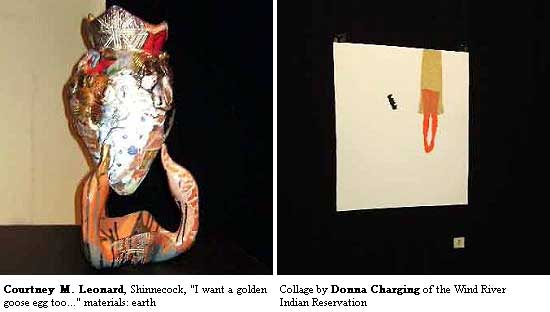
One, was a piece by Courtney M. Leonard, with the tribal affiliation of Shinnecock. Leonard is a grad student at RISD and presented a piece entitled “I want a golden goose egg too…” for which she listed the materials as “earth” Upon further exploration of the room I found she had a total of 3 pieces in the exhibit all of which had the same aesthetic and appeal to them. They resembled vessels and the first an egg with sculpted detailing and unique glazing. The thing that struck me most about them was the content of the imagery included on them. Stamps of strawberry shortcake and drawings of buildings adorn these traditional shapes as if to suggest the Americanization of her lifestyle and ideals. Almost caught between the two worlds of the traditional and modern. “Would this definition consider me as one (a traditional potter) if I admitted I began with play dough?” Leonard states in her explanation of her work. www.courtneymleonard.com Two as a cut origami paper and Rives BFK collage by Donna Charging of the Wind River Indian Reservation. This piece alluded to more but through her explanation I was unable to see the full truth behind it. The figure out of cut paper was suspended from the top right with what appeared to be hair, or a “scaling” falling away to the left. The legs on the figure seemed lifeless and dangling and I could not help but wonder what it was specifically about. I am unable to ask the artist this however and am still left wondering. www.donnacharging.worldecho.com 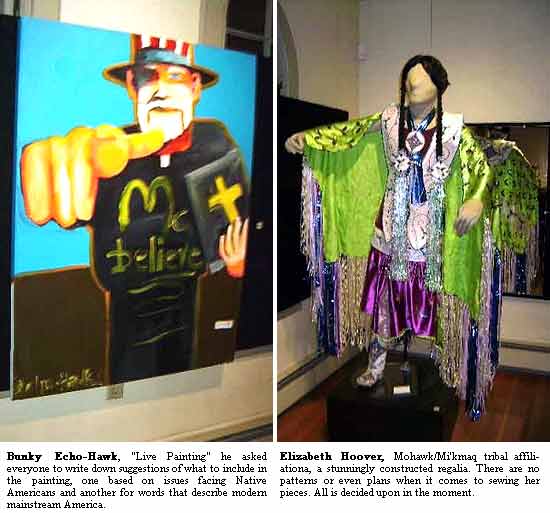
Three was a piece by Bunky Echo-Hawk, The piece featured had been produced as a “Live Painting” at Brown’s previous event in which he had set up to paint and did so by the suggestions of those in the room at the time. He asked everyone to write down suggestions of what to include in the painting, one based on issues facing Native Americans and another for words that describes modern mainstream America. People threw up ideas such as “domestic violence”, “Identity”, “mascots” and “fast food”, “Immigration” and “Britney Spears”. Ultimately it ended as a piece with a blue sky, almost annoyingly happy blue, with an “uncle Sam wants you” post to a man with a top hat and preachers uniform with blood trickling from the corners of his mouth and the words “Mc. Believe” across his chest. The piece as a whole is dynamic and impactful. The story of its creation just as much a part of the piece as the finished product itself. For a full article on this project visit this Brown-Daily-Herald-Link or www.bunkyechohawk.comFive was a stunningly constructed regalia by Elizabeth Hoover, Mohawk/Mi’kma
q tribal affiliation. This piece held onto its tradition wile incorporating the colors and ideas of the modern generations. I spoke with Ms. Hoover about her method and reasoning behind her work and found that she works much as a painter or other artist would. There are no patterns or even plans when it comes to sewing her pieces. All is decided upon in the moment, the works that result are as individual and intriguing as any other art form. 
Six was my piece, I had submitted “Time to Leave” a large acrylic on canvas which depicts women in brightly colored regalia boarding a black and white bus in a black and white cityscape. This piece was meant to represent the idea of being in a modern city and feeling out of place, remembering what was once there in its place. www.picturetrail.com/nayanag
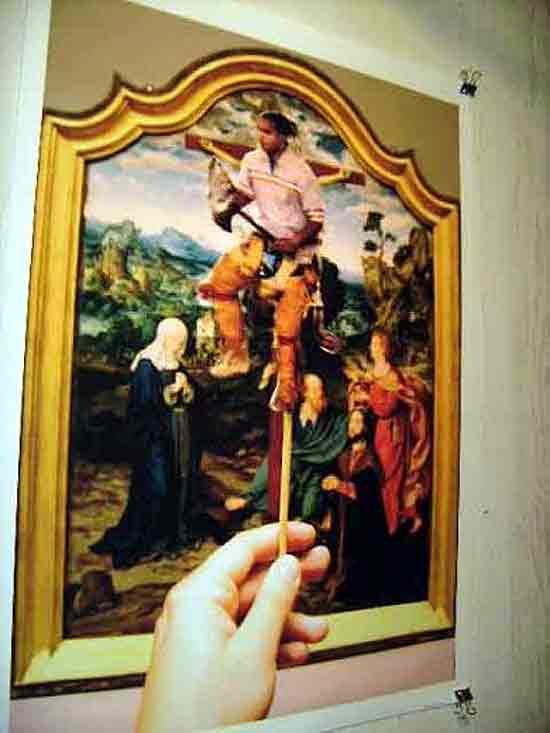
Dan Loudfoot, print enlargement with hand
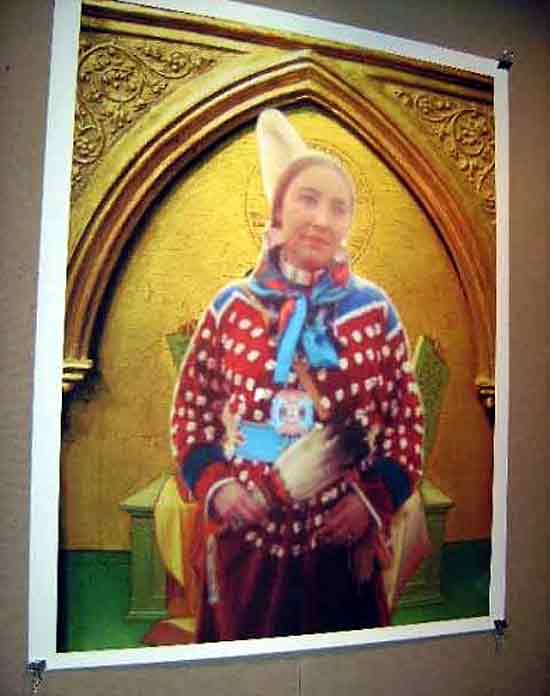
Dan Loudfoot, print enlargement
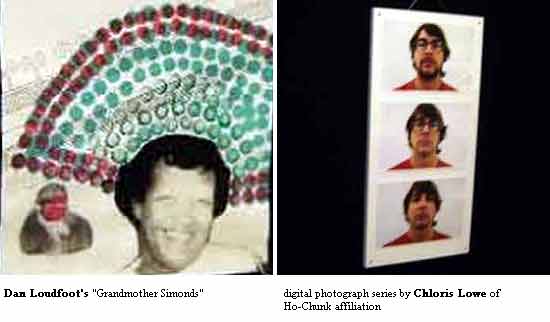
Seven was Dan Loudfoot’s “Grandmother Simonds”, he also had piece Thirteen “Everyone wants to be an Indian” and several pieces in the temporary room where the refreshments were held. Both pieces incorporate the use of bingo paint blotters to create traditional designs around a concept. In “Grandmother Simonds” he chose to put an image of his grandmother with that of a stereotypical Indian doll incorporating the bingo paint to form an almost mary-esque halo around his grandmothers head. “Everyone wants to be Indian” is an interactive piece in which visitors to the show sit in a chair positioning themselves to have their heads in the center of a circle of bingo paint with feathers at the top. These images will comprise a book when the exhibition is complete. www.danloudfoot.com
Four, a digital photograph series by Chloris Lowe of Ho-Chunk affiliation. This piece struck me because of its honesty and provocative ideas on identity related to being Native American. His piece spoke to me as a mixed blood native. Its title “searching for 1/4″ said it all for me. The series of three digital photographs, close ups on his face with small alterations such as glasses on or off reminded me of the experience of looking in the mirror searching for identity in what is easily seen. His physical appearance did not directly lead me to think he was of native ancestry and that is what made this piece the most interesting for me. There is always this feeling of non-acceptance for being or not being enough native and he tackled that issue in a ‘head on’ method. lowespaceartplace.blogspot.com 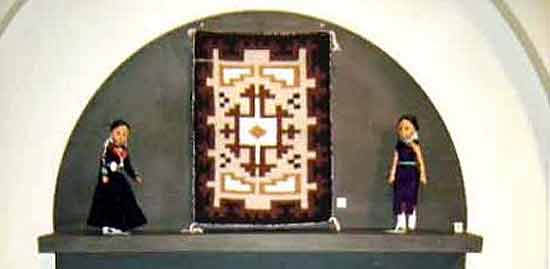 Winifred Bessie Jumbo, site specific placement of ritual objects
Winifred Bessie Jumbo, site specific placement of ritual objects
Eight and Nine are two dolls dressed in the traditional fashion by Winifred Bessie Jumbo of Navajo affiliation. Each element of the dolls outerwear means something about them and tells a story of where her life will go. These dolls are strangely generic in appearance as dolls themselves, it is what Jumbo does to them that make them unique and speak to the combining of ancient ideas and new ways. Her work speaks softly in its statement but has a deeper meaning that seems just within sight.
(picture unavailable)
Eleven were digital photographs by Jamie Spears of the RI Wampanoag who displayed images of her mother, cousin and cousin’s daughter at powwows. The thing that intrigued me about this work was the presence of such modern objects as head set microphones in otherwise traditional imagery.
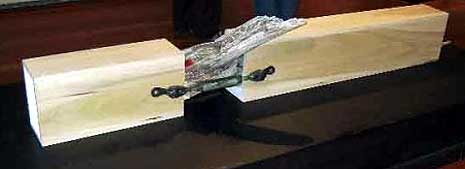 Chloris Lowe, object, wood, steel, bronze and fabric
Chloris Lowe, object, wood, steel, bronze and fabric
Fourteen I almost did not see at all, which is strange considering it is the largest piece in the show and positioned in the very center of the room. I rounded the room and on my way out realized that there were two pieces remaining. The last I soon found just outside the doorway but this number fourteen I had almost not seen. But when my eye finally fixated on it the whole perception of the room changed and it became impossible to enter the room with out seeing it. The piece is by Chloris Lowe, the same person who did the photographs that I found so poignant. This sculpture incorporates wood, steel, bronze and fabric to make an intimidating but organic feeling structure resembling a box pulled open at the center to reveal the remaining elements. Lowe says this piece stems from ideas on the medicine bundle. The objects inside came from personal stories and experiences of Lowe’s.
(picture unavailable)
Fifteen is a digital image created in Adobe Photoshop by Donovan Pete of Navajo affiliation. Entitled “Withered” this piece incorporated elements of the modern and ideas on the traditional to form a graphically strong composition which makes us wonder about what might come next. Kind of a perfect ending for the whole event.
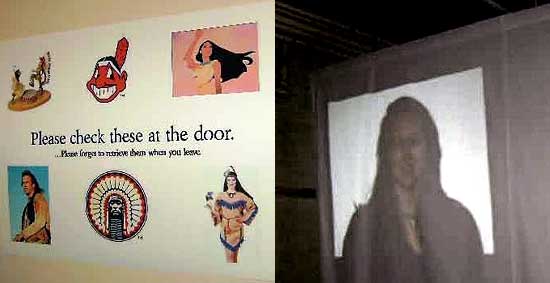 “Please check these at the door …Please forget to retrieve them when you leave”
“Please check these at the door …Please forget to retrieve them when you leave”On my way out I saw a sign at the door that I had missed on the way in asking us to leave our preconceived ideas on Native Americans at the door.
The turn out was fantastic for the space and the feeling in the room was an over all welcoming experience. Rather than the usual awkward interactions with other artists we found ourselves talking about our work and the ideas behind it. The overall feeling in the room was appreciation for the event-taking place. Each artist I spoke with expressed their experience of being surprised and excited that the topics handled in the show were being addressed and presented in such a public forum. Every person involved seemed to be genuinely excited and honored to be participating and have the opportunity to present these issues and ideas to the public.
Conversations on everything from art to history and pop culture were passed around as each of us found a small piece of the connectedness that so many of our works expressed the absence of.
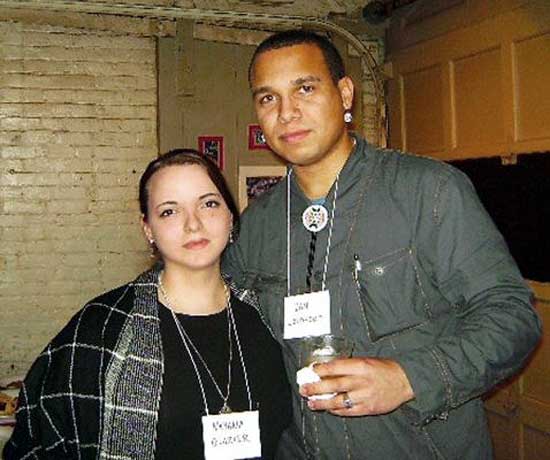 Nayana Glazier and Dan Loudfoot
Nayana Glazier and Dan Loudfoot
Upon leaving to make the drive home I said goodbye to Dan Loudfoot, who I had only just met in person that night, we both expressed a desire to take this concept and the one we had begun before and have the show travel. We will now be looking for venues around the country where we can have this same sort of event.
The perspectives of the artist on art are rarely altered, except when faced with something that achieves what they themselves have tried to achieve but could not. Then I think the artist must look at things differently. This show did that for me.
– Nayana
#permalink posted by Nayana: 3/10/08 10:13:00 PM




